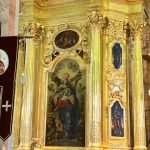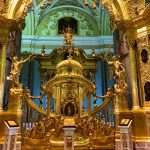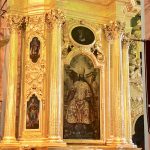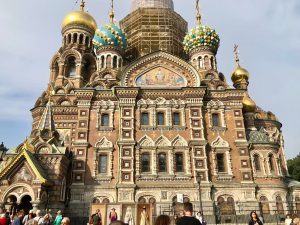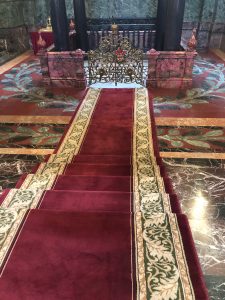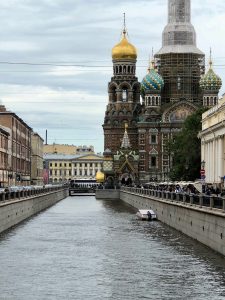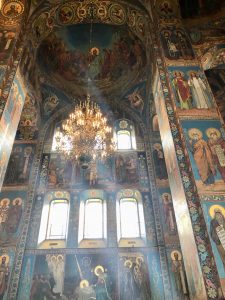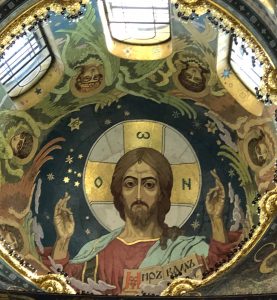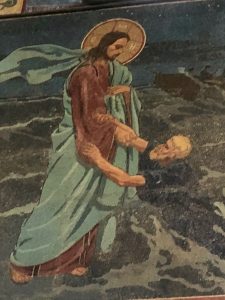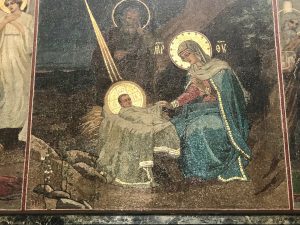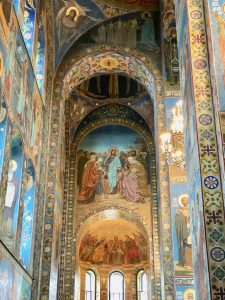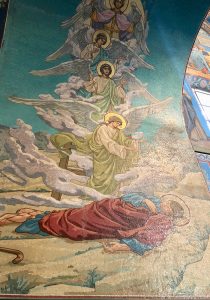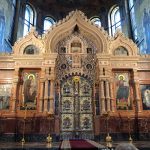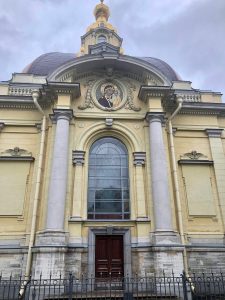 The CATHEDRAL OF SAINTS PETER AND PAUL was the second church in St. Petersburg. The first church was a wooden building consecrated in 1704. But it was never meant to last. Peter the Great wanted a cathedral to rival any building in Western Europe and brought in architect Domenico Trezzini to build a Baroque structure laid out on a rectangular base. Trezzini was working in Copenhagen when Peter brought him to Russia in 1703. Prior to his arrival, Trezzini was familiar with Lutheran churches but had no knowledge of Orthodoxy. Consequently, Trezzini included a preaching pulpit that has never been used.
The CATHEDRAL OF SAINTS PETER AND PAUL was the second church in St. Petersburg. The first church was a wooden building consecrated in 1704. But it was never meant to last. Peter the Great wanted a cathedral to rival any building in Western Europe and brought in architect Domenico Trezzini to build a Baroque structure laid out on a rectangular base. Trezzini was working in Copenhagen when Peter brought him to Russia in 1703. Prior to his arrival, Trezzini was familiar with Lutheran churches but had no knowledge of Orthodoxy. Consequently, Trezzini included a preaching pulpit that has never been used.
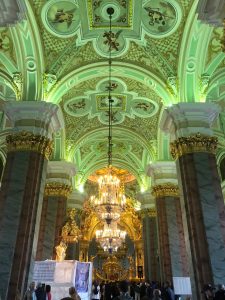 When I entered the building, I first noticed golden fixtures and a greenish hue. The second impression, of course, was of crowds of people.
When I entered the building, I first noticed golden fixtures and a greenish hue. The second impression, of course, was of crowds of people.
The Cathedral of Saints Peter and Paul, completed in 1733, is very much Peter the Great’s church. His tomb and that of his second wife Catherine (later Catherine I) is at the front of the Screen of Icons. On the right side of the screen is a large icon of Jesus, with an Imperial crown and a face that resembles Peter’s face. On the left, is an icon of the Virgin Mary, who resembles Peter’s wife.
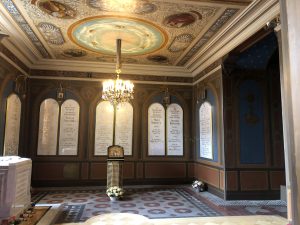 The cathedral is also the final resting place of almost all the Romanovs (excluding Peter II and Ivan VI). The last imperial remains belong to Nicholas I and his family and are housed in the Chapel of St. Catherine, the Martyr. The remains include those of four servants found with the family. These were interred in 1998. However, at the time most of the remains were found, those of Tsarevich Alexei and Grand Duchess Marie were missing. These were found later, but aren’t in the chapel. The church didn’t accept their authenticity.
The cathedral is also the final resting place of almost all the Romanovs (excluding Peter II and Ivan VI). The last imperial remains belong to Nicholas I and his family and are housed in the Chapel of St. Catherine, the Martyr. The remains include those of four servants found with the family. These were interred in 1998. However, at the time most of the remains were found, those of Tsarevich Alexei and Grand Duchess Marie were missing. These were found later, but aren’t in the chapel. The church didn’t accept their authenticity.
The most recent, and probably the last, internment is that of Tsarina Maria Feodorovna, wife of Alexander III. After the Russian Revolution, the tsarina fled home to Denmark where she died in 1928. In her will, she requested that her remains be returned to Russia and placed next to those of her husband, but not while the communists were in power. The remains were interred in 2006.
CHURCH OF THE SAVIOR ON THE SPILLED BLOOD
Alexander III built the Church of the Savior on the Spilled Blood as a memorial to his father on the very spot where the assassin fatally wounded Alexander II in 1881. Construction began in 1883 in the style of orthodox churches built in the sixteenth and seventeenth centuries.
The structure sits along the Griboedov Canal which was narrowed so the church could be built on the exact spot where Alexander II was attacked. Cobblestones were pulled up and identified by number so they could be placed exactly where they were on the fateful day. There is also a portion of the original bridge railing. Outside is a golden canopy marking the spot.
The church was completed in 1907 during the reign of Nicholas II. From 1907 to 1917, weekly requiems for Alexander II took place. The church’s interior walls are covered by over 7500 square meters of breathtaking mosaics.
In 1932, the Soviets closed the church. During World War II, it was used as a temporary morgue during the Siege of Leningrad. Our guide mentioned that after the war, the Soviets wanted to tear down the church in order to widen the canal, but specialists informed the government that there was no way to save the priceless mosaics created by Russian craftsmen. The government responded by turning the cathedral into a warehouse for the Small Opera Theater.
In 1970 the Church of the Savior on the Spilled Blood became part of the St. Isaac’s Cathedral Museum (more on that next week), underwent a complete restoration and opened to the public in 1997.
Photos by Author
Cathedral of Saints Peter and Paul
Church of the Savior on the Spilled Blood

Sandra Wagner-Wright holds the doctoral degree in history and taught women’s and global history at the University of Hawai`i. Sandra travels for her research, most recently to Salem, Massachusetts, the setting of her new Salem Stories series. She also enjoys traveling for new experiences. Recent trips include Antarctica and a river cruise on the Rhine from Amsterdam to Basel.
Sandra particularly likes writing about strong women who make a difference. She lives in Hilo, Hawai`i with her family and writes a blog relating to history, travel, and the idiosyncrasies of life.

